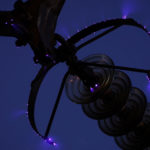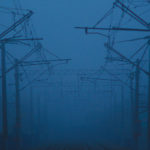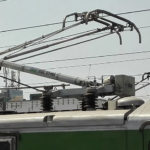The high-speed all-electric railroad locomotive uses a catenary-wire system and pantograph power-transfer arrangement, which appears to violate good engineering practice and should not work. Still, it does, transferring hundreds of amps via a contact point moving at over 100 miles/hour.
Part 1 looked at the basics of diesel-electric versus all-electric locomotives. This part looks at the power requirements in more detail.
The required locomotive-power rating needed is primarily a function of the weight to be pulled, desired acceleration, maximum speed, and nature of the trackage (level or uphill). Engine power typically ranges between 3,000 and 10,000 horsepower for both diesel-electric and all-electric designs. However, the diesel-electric gets very large and heavy with major cooling issues at the higher end, and this can be a very real constraint.
Some applications need more torque and less speed (such as pulling cars loaded with ore from mine to mill) while others need more speed and less torque (for passenger coaches over level, well-maintained track) but this can be adjusted via the electric-motor control, type of motor used, and power-transmission linkage for each approach. The efficiency of the all-electric locomotive and its lack of polluting exhaust led to the GG1, perhaps the ultimate American passenger locomotive (Figure 1). This locomotive as custom designed and built for the Pennsylvania Railroad with body styling by famous industrial and interior designer Raymond Loewy.

The Pennsylvania Railroad had Baldwin Locomotive Works build 139 GG1s between 1934 and 1943; the streamlined locomotive was mainly used for passenger trains and was symmetrical front/back for bidirectional use with the need to turn it around. These massive engines (460,000 lb.) could reach speeds of 100 miles/hour, and the electric motors had a peak horsepower rating of 8,000 horsepower (4,600+ horsepower in continuous operation). Although a reliable and hard-working engine, they were all retired in the 1980s due to difficulties of getting parts and providing maintenance. At the same time, the availability of highly improved control electronics and power devices such as IGBTs and SCRs allowed for smaller yet sufficiently powerful units for the commuter-rail task.
Powering the all-electric locomotive
The use of all-electric locomotives and even self-powered cars (which are locomotives in their own way) is not new. It was used in Europe in the late 1800s and early 1990s and inspired and enabled Alexander J. Cassat, president of the Pennsylvania Railroad, to build a pair tunnels under the Hudson River between New York and New Jersey in the early 1900s. This was impossible to do with steam-powered engines since the exhaust would “choke” the engine as well as the passengers (see EE World References).
As noted above, the electric power can be delivered to the locomotive using a “shoe,” which rides in or on a third rail mounted near the two running rails. This was used in the early days and is still used in many local commuter systems; the New York City subway uses it with 600 V DC power. However, it is mechanically and electrically unsuitable for operation at higher speeds, is impractical for many reasons at more-efficient, high-voltage/power levels, and has maintenance issues. It puts the full voltage potential of the system at literal (not electrical) ground level where it is prone to clogging from debris, potential (albeit dangerous) vandalism, and even can cause electrocution for anyone who wanders or falls onto the tracks. The relatively low value of maximum voltage it supports has high IR losses as power levels increase, as well.
Instead, for truly high-speed operation, the overhead pantograph-catenary-wire design is the approach used. Consider the voltage, current, and power levels involved, and its performance and reliability are impressive, especially considering how much current is being transferred “on the fly.” A rough calculation using the locomotives on the Amtrak Northeast Corridor line, and not taking into account any losses or inefficiencies, gives an idea of the magnitudes:
- Locomotive rated power is 8500 horsepower, so let’s roughly estimate that at 10,000 horsepower, or about 7.5 MW (1 horsepower is about 750 W)
- Overhead supply voltage is 25,000 V (60 Hz)
- Power = voltage × current, so the current is about 7.5 MW/25 kV = 300 A.
There’s no doubt that 300 A is a lot of current and 7.5 MW is a lot of power to transfer (keep in mind that IR drop is a function of current, wire resistance, and contact resistance, not voltage). Recall that one of the first “rules” of power distribution and rails (the electrical ones, not the train tracks) make sure that the cables and interconnections are hefty and secure, to minimize contact resistance and high-voltage arcing.
Yet the nature of the catenary/pantograph completely contradicts this rule. The locomotive has a sliding, non-fixed contact traveling at up to and sometimes exceeding 100 mph (160 km/hr) for the Amtrak Acela, and much faster on the European TGV, Chinese super-speed trains, or the Japanese Shinkansen bullet trains at 200 km/hr and reaching 300 km/hr. Yet the pairing works and has been field-proven over time, distance, and speed to work well.
Tomorrow, in Part 3 of this article, we will look at the pantograph and catenary system in more detail.
EE World References
“Electrified Locomotives, Tunnels, and the Pennsylvania Railroad: Astonishing engineering but a partially sad ending, Part 1: The challenge”
“Electrified Locomotives, Tunnels, and the Pennsylvania Railroad, Part 2: The tunnels”
“Electrified Locomotives, Tunnels, and the Pennsylvania Railroad, Part 3: The station”
External References
- Engineering Toolbox, “Cable Loads”
- The Railway Technical Website
- Ofil Systems, DayCor Rail
- Engineering Master, “Working of electric locomotive”
- Engineering Master, “What is Pantograph?”
- Allied Insulators, “Transmission & Distribution”
- “Railway Signalling Concepts”
- net, “Electric Traction Systems”
- Wikipedia, “Third Rail”
- Pennsylvania Railroad GG-1 Electric Locomotive
- Curbside Classic, “Trackside Classic: Pennsylvania RR GG1 #4935





I was wondering whether large batteries placed on the train could provide sufficient power to operate a locomotive and pull coaches